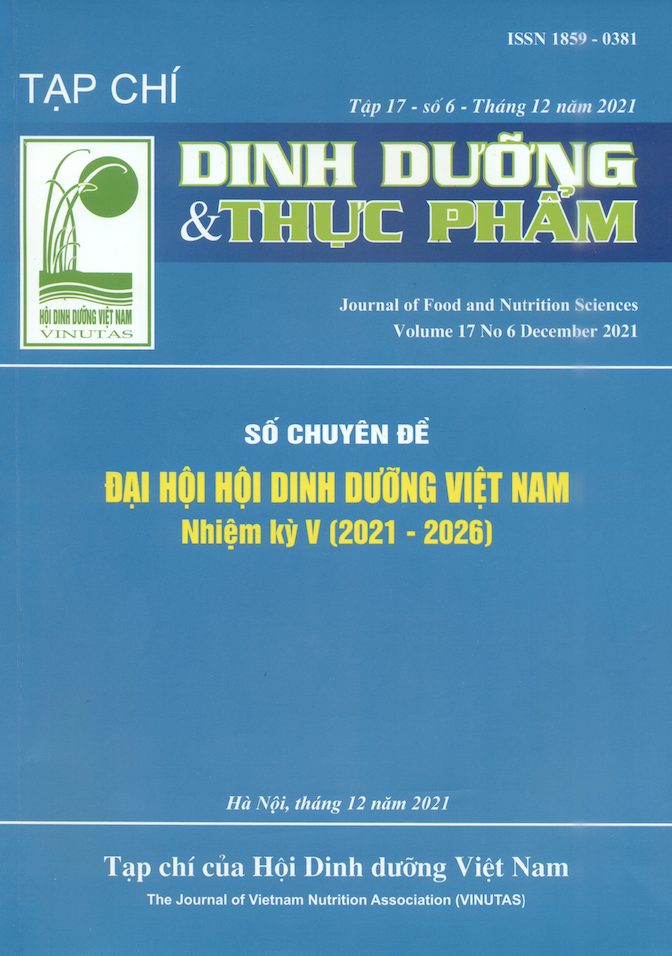REDUCED SALT DIET TO IMPROVE HEART HEALTH AND CONTROL HIGH BLOOD PRESSURE
Main Article Content
Abstract
Sodium chloride (NaCl) is a spice that stimulates the taste buds, brings out the salty taste and makes the dish more appetizing. However, excessive salt consumption is strongly associated with the development of a number of chronic non-communicable diseases. To limit salt intake, the Ministry of Health of Vietnam has set a target by 2025 to reduce the average salt consumption per person per day in adults by 30%. There are many methods to reduce salt consumption or reduce sodium intake such as actively reducing salt intake from foods and spices, using some salt substitutes such as potassium chloride, calcium chloride, magnesium chloride .... Especially, recently, the application of techniques using flavoring ingredients to maintain the palatability of salt-reduced foods is of interest to scientists. In this field, applying the umami flavoring ability of monosodium glutamate to partially replace sodium chloride is a method that is being applied effectively in many countries around the world.
Keywords
Axit amin, glutamate, mononatri glutamate (MSG), giảm muối, tăng huyết áp, duy trì vị ngon
Article Details
References
2. Gillette, (1985). Strategies to Reduce Sodium Intake in the United States.
3. Djin Gie Liem et al., (2011). Reducing Sodium in Foods: The Effect on Flavor. Nutrients. 2011, 3, 694-711
4. Rafaele Campo et al., (2020). Less Salt, Same Taste: Food Marketing Strategies via Healthier products. Sustainability, 12, 3916.
5. Karanja N. et al., (2007). Acceptability of Sodium-Reduced Research Di ets, Including the Dietary Approach es to Stop Hypertension Diet, among Adults with Prehypertension and Stage 1 Hypertension. J Am Diet As- soc., 107(9), pp. 1530-8
6. Rysová, J., & Šmídová, Z., (2021). Effect of Salt Content Reduction on Food Processing Technology. Foods (Basel, Switzerland), 10(9), 2237
7. Nelson G., Chandrashekar J., Hoon M., Feng L., Zhao G., Ryba N., et al., (2002). An amino-acid taste receptor. Nature, 416, pp. 199–202
8. Ninomiya K., (1998). Natural occurrence. Food Reviews International, Volume 14, pp. 2-3; 177-211
9. FDA, (2012). Questions and Answers on Monosodium glutamate (MSG).
10. JECFA, (1987). L – Glutamic acid and its ammonium, calcium, monosodium and potassium salts. Toxicological evaluation of certain food additives – Joint FAO/WHO Expert Panel on Food Additives. Cambridge. Cam- bridge University Press, pp. 97-161
11. US Food and Drug Administration, (1993). Code of Federal Regulations. Volume 408
12. (EC/SCF) Communities Commission of the European, 1991. 25th series of food additives of various technological functions. Report of the Scientific Committee for Food, p.16
13. Japanese Ministry of Health, La bour and Welfare, (2015). List of Designated Additives.
14. Bộ Y tế, (2019). Thông tư số 24/2019/TT-BYT ngày 30 tháng 8 năm 2019. p. 27
15. Codex Alimentarius Commision, (1999). Report of the twenty-sixth session of the Codex committee on food labelling.
16. Yamaguchi S. et al., (1984). Inter- action of monosodium glutamate and sodium on saltiness and palatability of a clear soup. J. Food. Sci, Volume 49, pp. 82-85
17. Jeremia Halim et al., (2020). The Salt Flip: Sensory mitigation of salt (and sodium) reduction with monoso dium glutamate (MSG) in “Better-for- You” foods. Journal of Food Science
18. Rosa, M.S.d.C., Pinto-e-Silva, M.E.M. and Simoni, N.K., (2021). Can umami taste be an adequate tool for reducing sodium in food preparations? Int. J. Food Sci. Technol., 56: 5315-5324.
19. Ủy ban Chiến lược Giảm tiêu thụ muối, Nhóm Dinh dưỡng và Thực phẩm, (2010). Henney JE, Taylor CL, Boon CS, Eds. Washington DC. Na tional Academies Press, 2010. 20. Bộ Y tế, 2015. Hướng dẫn điều trị dinh dưỡng lâm sàng. NXB Y học, 2015.


